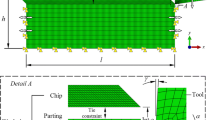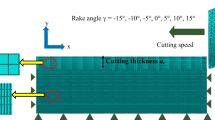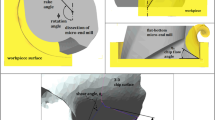Abstract
This study develops a combined numerical and experimental approach to get deeper insights into chip formation mechanism for high-speed machining of titanium alloy Ti6Al4V. The numerical investigation of high-speed machining is implemented with the aid of finite element analysis software Abaqus/Explicit, in which the Johnson-Cook (JC) fracture model with an energy-based ductile failure criterion is adopted. Meanwhile, the experiments of high-speed orthogonal cutting are carried out to validate the numerical results. The cutting speeds are selected ranging from 50 to 3,000 m/min, and the uncut chip thickness is fixed at 0.1 mm. The variables investigated include the serrated degree and serrated frequency of chips in addition to the cutting force. The results show that both the serrated degree and serrated frequency have positive correlations with the cutting speed. An important regularity for the transformation of chip morphology from serrated to unit at a critical cutting speed has been achieved, and the critical value for Ti6Al4V is about 2,500 m/min. The research also finds that the cutting force decreases with the increasing cutting speed, while its fluctuant frequency and amplitude increase sharply. Furthermore, the influences of JC fracture constants (the five constants in JC fracture model) on chip formation are investigated based on the finite element method, which is the main original and innovative highlight of this study. The shear localization sensitivity is firstly proposed to describe the influences of JC fracture constants on the chip formation process. When the JC fracture constants decrease, the shear localization sensitivity is positive which means that the serrated degree increases and vice versa. The sensitivity analyses indicate that the influences of initial failure strain D 1 and exponential factor of stress triaxiality D 2 on chip formation process are more conspicuous than the rest three ones. This paper is enticing from both the engineering and the analytical perspectives aimed at predicting the evolution of serrated chip formation and chip morphology transformation in metal cutting process.
Similar content being viewed by others
References
Ezugwu EO, Wang ZM (1997) Titanium alloys and their machinability—a review. J Mater Process Technol 68:262–274
Niu W, Bermingham MJ, Baburamani PS, Palanisamy S, Dargusch MS, Turk S, Grigson B, Sharp PK (2013) The effect of cutting speed and heat treatment on the fatigue life of grade 5 and grade 23 Ti-6Al-4V alloys. Mater Des 46:640–644
Arrazola PJ, Garay A, Iriarte LM, Armendia M, Marya S, Maître FL (2009) J Mater Process Technol 209:2223–2230
Armendia M, Garay A, Iriarte LM, Arrazola PJ (2010) Comparison of the machinabilities of Ti6Al4V and TIMETAL® 54 M using uncoated WC-Co tools. J Mater Process Technol 210:197–203
Sutter G, List G (2013) Very high speed cutting of Ti-6Al-4V titanium alloy-change in morphology and mechanism of chip formation. Int J Mach Tools Manuf 66:37–43
Molinari A, Soldani X, Miguélez MH (2013) Adiabatic shear banding and scaling laws in chip formation with application to cutting of Ti-6Al-4V. J Mech Phys Solids 61:2331–2359
Ginting A, Nouari M (2009) Surface integrity of dry machined titanium alloys. Int J Mach Tool Manuf 49:325–332
Bhaumik SK, Divakar C, Singh AK (1995) Machining Ti-6Al-4V alloy with a wBN-cBN composite tool. Mater Des 16:221–226
Bakkal M, Shih AJ, Scattergood RO (2004) Chip formation, cutting forces, and tool wear in turning of Zr-based bulk metallic glass. Int J Mach Tool Manuf 44:915–925
Sutter G (2005) Chip geometries during high-speed machining for orthogonal cutting condition. Int J Mach Tool Manuf 45:719–726
Joshi SS, Ramakrishnan N, Ramakrishnan P (2001) Micro-structural analysis of chip formation during orthogonal machining of Al/SiCp composites. J Eng Mater Technol 123:315–321
Shaw MC, Vyas A (1993) Chip formation in the machining of hardened steel. CIRP Ann Manuf Technnol 42:29–33
Nakayama K, Arai M, Kada T (1988) Machining characteristics of hard materials. CIRP Ann Manuf Technnol 37:89–92
Elbestawi MA, Srivastava AK, El-Wardany TI (1996) A model for chip formation during machining of hardened steel. CIRP Ann Manuf Technnol 45:71–76
Özel T (2009) Computational modelling of 3D turning: influence of edge micro-geometry on forces, stresses, friction and tool wear in PcBN tooling. J Mater Process Technol 209:5167–5177
Pramanik A, Zhang LC, Arsecularatne JA (2007) An FEM investigation into the behavior of metal matrix composites: tool-particle interaction during orthogonal cutting. Int J Mach Tool Manuf 47:1497–1506
Mabrouki T, Girardin F, Asad M, Rigal JF (2008) Numerical and experimental study of dry cutting for an aeronautic aluminium alloy (A2024-T351). Int J Mach Tool Manuf 48:1187–1197
Baker M (2005) Finite element investigation of the flow stress dependence of chip formation. J Mater Process Technol 167:1–13
Davim JP, Maranhão C (2009) A study of plastic strain and plastic strain rate in machining of steel AISI 1045 using FEM analysis. Mater Des 30:160–165
Zahedi SA, Demiral M, Roy A, Silberschmidt VV (2013) FE/SPH modelling of orthogonal micro-machining of f.c.c. single crystal. Comput Mater Sci 78:104–109
Calamaz M, Coupard D, Girot F (2008) A new material model for 2D numerical simulation of serrated chip formation when machining titanium alloy Ti-6Al-4V. Int J Mach Tool Manuf 48:275–288
Rosa PAR, Martins PAF, Atkins AG (2007) Revisiting the fundamentals of metal cutting by means of finite elements and ductile fracture mechanics. Int J Mach Tool Manuf 47:607–617
Zhang YC, Mabrouki T, Nelias D, Gong YD (2011) FE-model for titanium alloy (Ti-6Al-4V) cutting based on the identification of limiting shear stress at tool-chip interface. Int J Mater Form 4:11–23
Chen G, Ren CZ, Yang XY, Jin XM, Guo T (2011) Finite element simulation of high-speed machining of titanium alloy (Ti-6Al-4V) based on ductile failure model. Int J Adv Manuf Technol 56:1027–1038
Childs THC (1998) Material property needs in modeling metal machining. Mach Sci Technol 2:303–316
Astakhov VP, Outeiro JC (2005) Modeling of the contact stress distribution at the tool-chip interface. Mach Sci Technol 9:85–99
Guo YB, Yen DW (2004) A FEM study on mechanisms of discontinuous chip formation in hard machining. J Mater Process Tech 155–156:1350–1356
Özel T, Zeren E (2007) Finite element modeling the influence of edge roundness on the stress and temperature fields induced by high-speed machining. Int J Adv Manuf Technol 35:255–267
Ambati R, Yuan H (2011) FEM mesh-dependence in cutting process simulations. Int J Adv Manuf Tech 53:313–323
Umbrello D (2008) Finite element simulation of conventional and high speed machining of Ti6Al4V alloy. J Mater Process Technol 196:79–87
Hosseini E, Kazeminezhad M (2011) Implementation of a constitutive model in finite element method for intense deformation. Mater Des 32:487–494
Mabrouki T, Rigal JF (2006) A contribution to a qualitative understanding of thermo-mechanical effects during chip formation in hard turning. J Mater Process Technol 176:214–221
Menezes PL, Avdeev IV, Lovell MR, Higgs CF III (2014) An explicit finite element model to study the influence of rake angle and friction during orthogonal metal cutting. Int J Adv Manuf Technol. doi:10.1007/s00170-014-5877-5
Deng WJ, Xia W, Tang Y (2009) Finite element simulation for burr formation near the exit of orthogonal cutting. Int J Adv Manuf Tech 43:1035–1045
Abaqus Inc (2006) Analysis user’s manual. Version 6.6, USA
Johnson GR, Cook WH (1983) A constitutive model and data for metals subjected to large strains, high strain rates and high temperatures. In: Proceedings of the seventh international symposium on ballistics. Hague, Netherlands. 541–547
Johnson GR, Holmquist TJ (1989) Test data and computational strengthen and fracture model constants for 23 materials subjected to large strain, high-strain rates, and high temperatures. Los Alamos National laboratory, LA-11463-MS
Johnson GR, Cook WH (1985) Fracture characteristics of three metals subjected to various strains, strain rates, temperatures and pressures. Eng Fract Mech 21:31–48
Hillerborg A, Modéer M, Petersson PE (1976) Analysis of crack formation and crack growth in concrete by means of fracture mechanics and finite elements. Cem Concr Res 6:773–781
Schulz H, Abele E, Sahm A (2001) Material aspects of chip formation in HSC machining. CIRP Ann Manuf Technnol 50:45–48
Belhadi S, Mabrouki T, Rigal JF, Boulanouar L (2005) Experimental and numerical study of chip formation during straight turning of hardened AISI 4340 steel. Proc Inst Mech Eng Part B: J Eng Manuf 219:515–524
Liu ZQ, Su GS (2012) Characteristics of chip evolution with elevating cutting speed from low to very high. Int J Mach Tool Manuf 54–55:82–85
Molinari A, Musquar C, Sutter G (2002) Adiabatic shear banding in high speed machining of Ti-6Al-4V: experiments and modeling. Int J Plast 18:443–459
Author information
Authors and Affiliations
Corresponding author
Rights and permissions
About this article
Cite this article
Wang, B., Liu, Z. Investigations on the chip formation mechanism and shear localization sensitivity of high-speed machining Ti6Al4V. Int J Adv Manuf Technol 75, 1065–1076 (2014). https://doi.org/10.1007/s00170-014-6191-y
Received:
Accepted:
Published:
Issue Date:
DOI: https://doi.org/10.1007/s00170-014-6191-y




